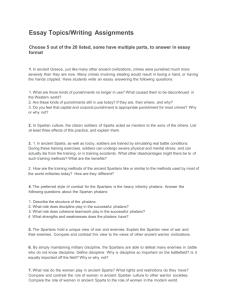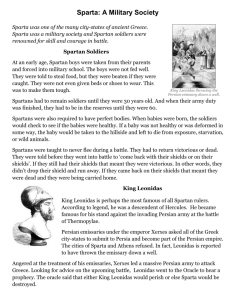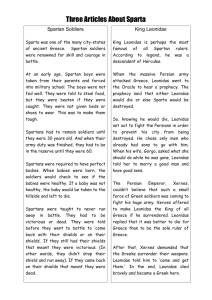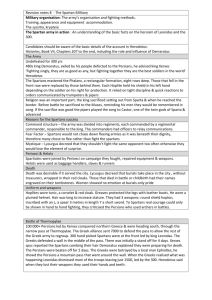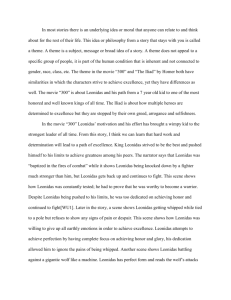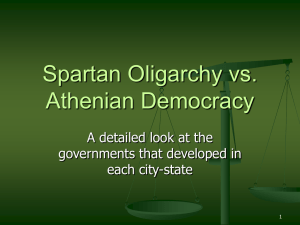Skills of the Spartans: Exploring Leadership in 300
advertisement
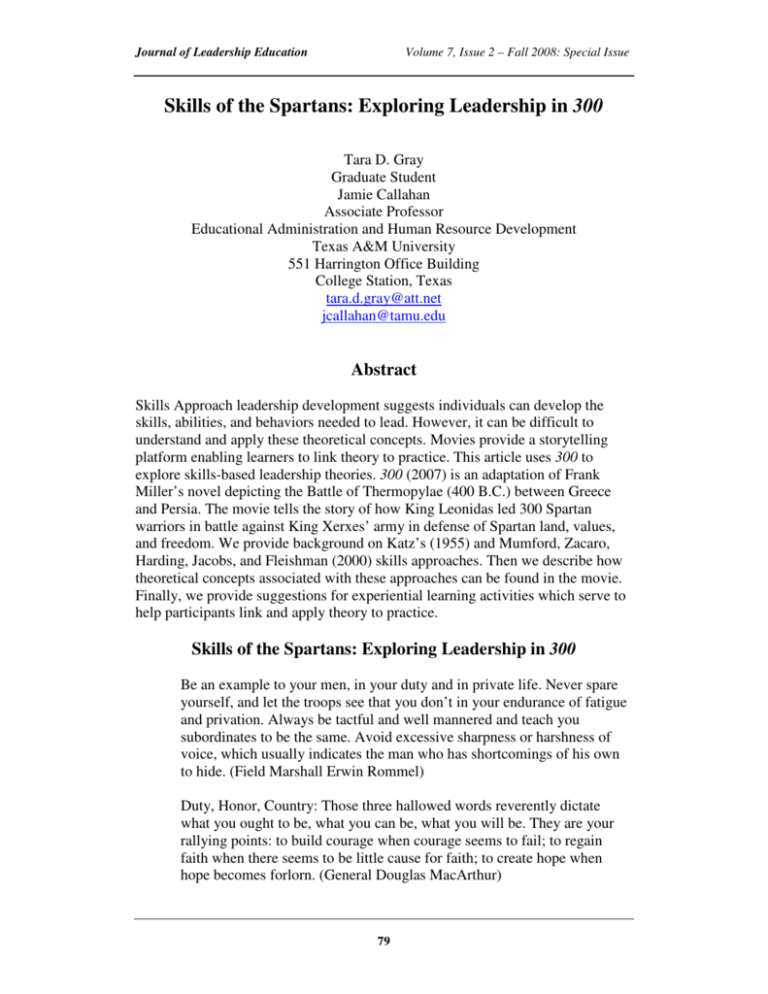
Journal of Leadership Education Volume 7, Issue 2 – Fall 2008: Special Issue Skills of the Spartans: Exploring Leadership in 300 Tara D. Gray Graduate Student Jamie Callahan Associate Professor Educational Administration and Human Resource Development Texas A&M University 551 Harrington Office Building College Station, Texas tara.d.gray@att.net jcallahan@tamu.edu Abstract Skills Approach leadership development suggests individuals can develop the skills, abilities, and behaviors needed to lead. However, it can be difficult to understand and apply these theoretical concepts. Movies provide a storytelling platform enabling learners to link theory to practice. This article uses 300 to explore skills-based leadership theories. 300 (2007) is an adaptation of Frank Miller’s novel depicting the Battle of Thermopylae (400 B.C.) between Greece and Persia. The movie tells the story of how King Leonidas led 300 Spartan warriors in battle against King Xerxes’ army in defense of Spartan land, values, and freedom. We provide background on Katz’s (1955) and Mumford, Zacaro, Harding, Jacobs, and Fleishman (2000) skills approaches. Then we describe how theoretical concepts associated with these approaches can be found in the movie. Finally, we provide suggestions for experiential learning activities which serve to help participants link and apply theory to practice. Skills of the Spartans: Exploring Leadership in 300 Be an example to your men, in your duty and in private life. Never spare yourself, and let the troops see that you don’t in your endurance of fatigue and privation. Always be tactful and well mannered and teach you subordinates to be the same. Avoid excessive sharpness or harshness of voice, which usually indicates the man who has shortcomings of his own to hide. (Field Marshall Erwin Rommel) Duty, Honor, Country: Those three hallowed words reverently dictate what you ought to be, what you can be, what you will be. They are your rallying points: to build courage when courage seems to fail; to regain faith when there seems to be little cause for faith; to create hope when hope becomes forlorn. (General Douglas MacArthur) 79 Journal of Leadership Education Volume 7, Issue 2 – Fall 2008: Special Issue Rommel and MacArthur are acknowledged as two of the most revered military leaders of the 20th century. Their words above highlight the importance of duty in being a successful leader. As understood in the military, duty constitutes what you must ‘do’ — the tasks you perform and the skill with which you perform those tasks (American Heritage Dictionary, 1985). The foundation of leadership in the military rests on one’s skills and abilities (McAleer, 2003). Leadership is frequently studied through the lens of the military, perhaps because the stakes of military leadership are measured in terms of life and death. Thus, a movie about the heroic leadership of one of history’s most epic military battles presents a fertile ground for exploring skills-based leadership theories. Released in 2007, the movie 300 is an adaptation of Frank Miller’s fictional graphic novel depicting the Battle of Thermopylae which took place in 400 B.C. between Greece and Persia. The movie tells a vivid and graphic story of how King Leonidas leads 300 Spartan warriors through battle against King Xerxes’ Persian army in defense of Spartan land, values, and freedom. The movie begins as a narration describing these Spartan virtues and the development of a boy, Leonidas, through Agogi, a Spartan custom which develops young boys into warriors. 300 reveals the skills and attributes young Leonidas learns which allow him to become a future warrior and King of the Spartans. At its core, 300, like many other forms of popular culture, is a story. Stories record important events, help people make sense of complex situations, impart cultural values and beliefs, and provide opportunities to link theory and practice (Collison & Mackenzie, 1999; Callahan, Whitener, & Sandlin, 2007). We suggest, then, that the stories shared through movies can be effective tools for teaching theoretical concepts such as leadership. In this article, we look specifically at two theories of skills-based leadership – Katz’s (1955) Three Skills Approach and Mumford, Zacaro, Harding, Jacobs, and Fleishman’s (2000) Skills Model. Because skills concepts are important to leadership, we use the movie 300 as a platform for participants to identify, relate, and apply these leadership concepts. The article concludes with suggestions on how to facilitate experiential learning activities linking and applying scenes from the movie to concepts of skills-based leadership. Skills Approach The skills approach to leadership can be considered one of the leader-focused theories that attempt “to describe leadership through the characteristics and behaviors of the leaders themselves” (Callahan et al., 2007, p. 148). Identifying effective skills has long been an approach to understanding and improving leadership (Lord & Hall, 2005). Unlike the trait approach which preceded skillsbased approaches to leadership, the skills approach suggests that leadership skills and abilities can be learned and developed over time. This makes skills-based 80 Journal of Leadership Education Volume 7, Issue 2 – Fall 2008: Special Issue approaches particularly relevant for leadership development training and education programs. Leaders should be aware of and understand the structural models and foundational concepts of leadership skill development so that they develop effective leadership skills, abilities, and behaviors (Mumford, Marks, Connelly, Zaccaro, & ReiterPalmon, 2000). In a recent study of a leadership development program, GilpinJackson and Bushe (2006) found that participants were more likely to learn and develop new knowledge, skills, and behaviors if they were able to both observe others using the new knowledge and skills and practice applying the knowledge and skills themselves. This is particularly important for leadership educators whose very work involves developing those skills and abilities in others. The movie 300 can be used to help demonstrate and apply the concepts in the skills approach. For the sake of simplicity and clarity, we will focus specifically on the constructs of two wellknown models, Katz’s (1955) Three Skill Approach and Mumford et al.’s (2000) Skills Model, as vehicles for exploring leadership skills within the movie. One of the earliest skills based approaches to leadership is Katz’s Three Skills approach (Northouse, 2007). Katz suggested leadership effectiveness is based on technical, human, and conceptual skills. Specifically, technical skill refers to one’s knowledge and proficiency in a specific area. Human skill refers to one’s ability to work with people, especially an understanding of and adapting to differences as well as creating a trusting relationship. Conceptual skill refers to one’s ability to understand and relate concepts and ideas to the big picture, goals, and vision. Mumford and his colleagues suggested effective leadership is based on competencies (knowledge and skills), individual attributes (motivation, personality, and cognitive ability), and leadership outcomes (performance). Specifically, “knowledge is the accumulation of information and the mental structures used to organize that information” (Northouse, 2007, p. 47), and is the ability to develop mental structures to learn and organize information. Cognitive ability refers to one’s intelligence, reasoning skills, and memory skills as well as knowledge acquired throughout life, which influences improved problem-solving and reasoning skills as a result of this acquired knowledge. Motivation refers to one’s desire to lead, ability to influence, and commitment to the organization. The Skills Model further suggests that one’s career experiences and environments (e.g., access to education, technology, etc.) influence one’s development of competencies and individual attributes (Northouse, 2007). These two skills-based approaches to leadership continue to inform leadership theories and models. For that reason, Katz’s (1955) and Mumford’s et al. (2000) concepts are important seminal approaches to understand the broader spectrum of skills-based approaches to leadership. Although the labels may change slightly 81 Journal of Leadership Education Volume 7, Issue 2 – Fall 2008: Special Issue and the skills listings may be expanded somewhat, newer approaches to skillsbased leadership still hold vestiges of these early attempts to define leadership through the skills of an individual. For example, Sternberg (2003) proposed a new skills-based approach that included a synthesis of wisdom, intelligence, and creativity. These are roughly equivalent to Katz’s (1955) human, technical, and conceptual skills. For another example, Lord and Hall (2005) include skills that equate to the knowledge, skills, cognitive ability, and personality components of Mumford’s et al. Three Skills Model, and they add an identity component that somewhat extends the individual attributes component of the Three Skills Model. In the pages that follow, we first graphically depict the connections between these two seminal approaches to skills-based leadership. Then, we describe the movie and the basic links between skills-based leadership and the screenplay. A detailed table is provided to make these links accessible as teaching notes for educators. Finally, we provide a table of proposed activities to make using this film to teach skills-based leadership as convenient as possible for educators. 82 Journal of Leadership Education Volume 7, Issue 2 – Fall 2008: Special Issue Table 1: Comparison of Katz’s (1955) and Mumford et al.’s (2000) leadership effectiveness and development models Katz’s (1955)Three Skills Approach Model Construct Mumford et al.’s (2000) Skills Model Model Construct Developed Abilities Developed Abilities Knowledge. Technical Building knowledge and proficiency in an area. Competencies Skills. Motivation, including: - Desire to lead. - Ability to influence others. - Commitment to the organization, goal, vision, etc. Working with people, especially: Human Understanding differences. Adapting to differences. Individual Attributes Creating a trusting relationship. Understand concepts and ideas. Conceptual Mental structures to organize information and knowledge. Relate concepts and ideas to the vision, goal, big picture. Leadership Outcomes Influences on Development Personality Cognitive Abilities, including - Intelligence. - Reasoning Skills. - Memory, which improves problem solving and reasoning skills. Performance. Environment (e.g., access to education, technology, etc.). Career experiences. (Northouse, 2007) 83 Applying the Skills Approach to 300 Callahan and Rosser (2007) note that, “Using [movies] is not a substitute for good teaching, facilitating, or training; it is not sufficient to pop a videotape or DVD into the machine and then leave the room for a few hours to catch up on other work” (p. 272). Incorporating movies into leadership education requires much thought and preparation. The first important step is to identify key linkages between the movie and the desired learning outcomes, including capturing specific scenes that relate to specific theoretical concepts. This section provides an overview of key elements of the story of 300 and how they relate to the concepts found in skills-based leadership approaches. The movie begins with the narrator describing Spartan values. As a boy, Leonidas spars with an adult man while the narrator explains, “By the time he could stand, he was baptized in the fire of combat. Taught never to retreat; never to surrender. Taught that death on the battle field in service to Sparta is the greatest glory he could achieve in his life” (Snyder, D., Miler, F., Flores, C. J, Tull, T., Fay, W., & Waisbren, B. (Producer), & Snyder, Z (Director), 2007, Scene 1). It is evident boys are taught values and skills to succeed as a Spartan warrior and leader on the battlefield at a young age. At the age of seven, boys leave home for Agog – a custom “manufactured by 300 years of Spartan warrior society to create the finest soldiers the world has ever known” (Snyder et al., 2007, Scene 1). 300 focuses on King Leonidas’ development and demonstration of leadership skills. When the boy Leonidas leaves home for Agogi, he is placed into violent, harsh, and wild scenarios, including situations in which he is forced to fight to defend himself, to avoid starvation, to survive, to “return to his people a Spartan, or not at all” (Snyder et al., 2007, Scene 1). Adopting this vision, young Leonidas successfully defends himself against a wolf which was larger than him. However, it is not the act itself; it is the manner in which it was done. The environment was less than favorable because he was by himself, at night, in extreme cold with little clothing, and only a spear for defense. He had the cognitive ability to devise a plan and, because of his training in Agogi, he developed the technical skills and knowledge (competencies) to execute the plan. Young Leonidas intentionally becomes extremely observant and aware as he analyzes his surroundings, the situation, and the wolf’s behaviors. He uses this information to position himself to help ensure accurate execution. This is a demonstration of Katz’s (1955) technical and conceptual skills as Leonidas analyzes the situation, draws conclusions, and uses his knowledge and abilities to make decisions and act in order to accomplish his goal – survival. According to Mumford et al.’s (2000) model, Leonidas demonstrates his competencies and individual attributes, specifically knowledge, mental structures, and cognitive abilities. And, as a result, as exclaimed by the narrator, his performance is “perfect” (Snyder et al., 2007, Scene 1). 84 The story fast forwards to King Leonidas sparring with his son – teaching him, “A Spartan’s true friend is the warrior next to him. So, give respect and honor to him; and, it will be returned to you” (Snyder et al., 2007, Scene 2). This is a representation of human skills and individual attributes through influencing others as he not only expresses his values of respect, honor, friendship, and supporting those whom you care about, but he is passing on these values to his son. The lesson is interrupted by a Persian messenger requesting King Leonidas to submit Sparta to Xerxes’ Persian Empire. Offended by the messenger’s behavior, King Leonidas rejects the request by kicking the messenger and his entourage into a pit where they fall to their death. It is not the act itself; it is the manner in which it was done. Leonidas, now king, once again intentionally becomes extremely aware of his situation and analyzes it before executing his rejection of the Persian entourage. Similar to his encounter with the wolf, he demonstrates his conceptual skills as well as his competencies and individual attributes through knowledge and cognitive abilities. As king, and as a Spartan, he is defending Sparta’s values, beliefs, freedom, and reputation. Submitting to Xerxes could mean losing these which is his motivation (individual attributes) to execute his rejection. Knowing Xerxes would eventually advance toward and attempt to conquer Sparta, King Leonidas presents a war strategy to the Ephors, holy men. Already bribed by Xerxes, the Ephors reject King Leonidas’ strategy and instruct him that Sparta should not go to war. Yet, King Leonidas ignores their instructions, gathers 300 of Sparta’s best soldiers, and marches towards the “Hot Gates,” a narrow strip of land between the coastal cliffs and mountains of Thermopylae to battle Xerxes’ army. Before the Spartan soldiers march from Sparta, Leonidas notices that his captain recruited his own son and says him, “You are a good friend, but a better captain, there is none” (Snyder et al., 2007, Scene 7). Not only an expression of Leonidas’ value of friendship and respect (human skills); but, it is also a representation of how much the captain respects and honors Leonidas and his mission. Along the way, the 300 meet a formation of Arcadians, fellow Greeks, offering to join forces with Sparta to battle Xerxes. The Arcadian leader is shocked at the small size of King Leonidas’ army. Leonidas asks a few members of the Arcadian army their profession to which their replies indicate the army is comprised of men from skilled labor and craft related occupations. Leonidas submits the same question to the Spartan army to which they reply in unison a battle cry indicating they are soldiers by trade or profession. By making the point that the Spartan army has more soldiers than the Arcadians, he eases the Arcadians’ concerns about Sparta’s small numbers. In doing so, he successfully influences them to join forces with Sparta, which is a representation of human skills as well as individual attributes through his ability to recognize differences and influence others. 85 Leonidas also demonstrates respect to the Spartan soldiers for their skills, abilities, and value, or human skills. These skills are further represented during his interaction with Ephialtes, a disfigured Spartan following the Spartan army to the Hot Gates. Ephialtes eagerly and passionately offers his services and demonstrates his abilities to help Leonidas’ men fight against the Persian army. Leonidas listens and observes Ephialtes, noticing that he cannot lift and hold his shield above his shoulder. Leonidas recognizes and respects Ephialtes for the skills he has with his spear, but, as a leader, Leonidas has to acknowledge Ephialtes does not have the complete set of skills to be a soldier. Nor does Leonidas simply reject Ephialtes; he provides feedback in a supportive manner as well as suggests Ephialtes can add value in other areas such as clearing the battle field, which is a task that still supports the goal of the army. Leonidas fights not only along side the Spartan soldiers, but on the front line; an indication of leading by example as well as his confidence in his abilities to fight and survive. During the first battle, Leonidas confidently charges and displays the technical skills and problem-solving abilities (knowledge and individual attributes) learned during Agogi as he strikes his opponents without hesitation and with excellent execution and precision. After the second battle, Xerxes offers Leonidas wealth, power, and conditional control over Greece in exchange for his surrender and submission. Rejecting Xerxes’ offer, Leonidas declares his loyalty to Sparta, their values, and his vision. Even after narrowly missing decapitation in the second battle, Leonidas continues to lead the Spartans through what appears to be another four battles in defense of Spartan freedom, land, and honor with very little casualties. After what appears to be the sixth battle, the Arcadian army leader informs Leonidas that Xerxes’ army is approaching from the rear of the Hot Gates, declares the battle is over, and advises him to retreat, surrender, or die. To which Leonidas responds, “Spartans never retreat, Spartans never surrender” (Snyder et al., 2007, Scene 24). Despite the Arcadian leader declaring the Arcadian army is leaving, Leonidas calls the Spartans to re-engage and continue with the battle. This is a representation of Leonidas’ individual attributes as he continues to support Sparta’s mission, vision, and motivation. Leonidas also recognizes at this point that the next battle against Xerxes’ army may be the last. He instructs one of his soldiers, Dilios, to return to Sparta with his final orders to the Spartan council; “You are to live out my final orders to the council…tell them my story…tell of victory” (Snyder et al., 2007, Scene 25). Xerxes again offers Leonidas wealth, power, and continued reign over Sparta in exchange for his surrender and submission. Leonidas kneels, lays down his shield, removes his helmet, appearing as if he is surrendering. Yet, once again, he 86 intentionally becomes more aware of his environment in preparation for execution. He removed his obstructive helmet, laid down his heavy shield, dropped his spear, and knelt. This caused Xerxes’ and his army to think Leonidas was surrendering; furthermore, as the narrator explains, Leonidas’ actions allowed him to steady his balance and focus his strength and eye sight to throw his spear and lacerate Xerxes from a long distance. Yet, again, he demonstrates his technical and conceptual skills in addition to competencies and individual attributes as he uses his knowledge and cognitive abilities to assess the situation, draw conclusions, make decisions, and successfully execute. However, in combination with his instructions to Dilios, it is this scene that culminates Leonidas’ human, technical, and conceptual skills as well as competencies and individual attributes as a leader. Conceptually, he knew this would be his final battle against Persia. As a result, the purpose of the battle was to show everyone that Xerxes can bleed like, and is just like, any other man. By doing so, it will put Sparta closer to winning the war against a man who considers himself a god king, immortal, and invincible. Leonidas had the vision, motivation, and cognitive skills to devise a plan as well as the personality and relationships to influence his soldiers to go along with his plan. He performed well. Even as he himself is dying, Leonidas continues to demonstrate his human skills through expressing his respect and honor to those he leads, those he cares about. A Spartan soldier dying on the battle field reaches for Leonidas saying, “It is an honor to die at your side.” Severely injured himself, King Leonidas responds, “It is an honor to have lived at yours.” (Snyder et al., 2007, Scene 28) While Leonidas did not lead the Spartan soldiers in defeating Xerxes, he did lead them to victory through many battles with a fraction of the men in the Persian army. The Persian’s loss in the final battle later allowed Sparta to win the war against Xerxes. Tools for the Educator While the previous section provided the first step for using movies in leadership education (i.e., an overview of how theory linked to practice in the movie), this section provides the second step. Here we provide concrete examples leadership educators can use to incorporate this movie into a leadership development program. Application First, we suggest that educators introduce and present the leadership approaches, including main theories, concepts, and models prior to using 300 as an experiential learning activity. This helps ensure the participants have sufficient awareness and information to recognize and apply the constructs and developed 87 abilities of Katz’s (1955) and Mumford et al.’s (2000) skills models while viewing the film. The movie 300 can be viewed in entirety or by specific scenes in which the facilitator stops the movie to discuss Skills Approach concepts apparent in the film such as those referenced in Table 2. Because scenes 5, 6, 22, and 23 have nudity and sexual content, some facilitators may want to avoid these scenes. Table 3 references additional recommendations to guide participants in identifying the developed abilities demonstrated by Leonidas, relating them to Katz’s (1955) and Mumford et al.’s (2000) models, as well as facilitate discussion and application between the Skills Approach and 300. 88 Table 2: Linking Katz’s and Mumford et al.’s models to 300 Katz’s (1955) Three Skills Approach Model Construct • Developed Abilities Mumford et al.’s (2000) Skills Model Model Construct • Developed Abilities Relating to 300 Scenes Scene (s) Introduction to Spartan values and Agogi. Leonidas’ experiences prior to and during Agogi. 1 2 2–3 Competencies • Knowledge Technical • Mental structures to • Building organize knowledge and proficiency in information an area. and knowledge. • Skills Description 13 Demonstration of Leonidas’ learned skills, abilities, and behaviors, especially his ability to become highly aware of and assess a situation before executing. King Leonidas teaching his son fighting skills and behaviors. A Persian messenger presents Leonidas with a proposition to submit to Xerxes. Demonstration of Leonidas’ ability to assess a situation before executing. Ephialtes offers his services and demonstrates his abilities to help fight the Persian army. Demonstration of Leonidas’ ability to identify and assess others’ skills and abilities and determine if they match those needed for success. Sparta’s first battles against Xerxes’ armies. Demonstration of Leonidas’ confidence 14 – 15 as well as technical and problem solving skills as he strikes without hesitation and with excellent execution and precision. Even after Leonidas narrowly misses decapitation, he continues to lead the Spartans through another four battles 18 - 21 with very little casualties compared to the Persian army. Xerxes makes a third proposition to Leonidas in exchange for his submission. 27 - 28 Demonstration of Leonidas’ ability to become extremely aware of and assess his situation in preparation for execution. (Table 2. continued) 89 Table 2 (continued) Katz’s (1955) Three Skills Approach Model Construct • Developed Abilities Mumford et al.’s (2000) Skills Model Model Construct • Developed Abilities Relating to 300 Scenes Scene (s) A Persian messenger presents Leonidas with a proposition to submit to Xerxes. 2-3 Individual Attributes • Motivation, including: • Desire to lead • Ability to influence others • Commitmen t to the Human organization • Working with , goal, people; vision, etc. • Understanding differences • Personality • Adapting to differences • Cognitive • Creating a Abilities, trusting including relationship • Intelligence • Reasoning skills • Memory, which improves problem solving and reasoning skills Description 7 8 Demonstration of Leonidas’: Ability to become extremely aware of and assess a situation in preparation for execution. Dedication to Spartan values. Despite the Ephors demanding Sparta should not go to war, Leonidas continues with his plan. Demonstration of: 300 men supporting his vision. The Captain’s respect and honor for Leonidas and his mission. Leonidas’ value of the Captain’s friendship as well as respect for his skills. The 300 encounter an Arcadian formation offering to join forces. Demonstration of Leonidas: Ability to ease the Arcadians’ concerns about Sparta’s small number. Respect to the Spartan soldiers for their skills, abilities, and value. Ephialtes offers his services and demonstrates his abilities to help fight the Persian army. 13 Demonstration of Leonidas’ ability to: Listen, observe, and respect abilities and differences. Identify and assess others’ skills and abilities and determine if and where they best fit. Sparta’s first battles against Xerxes’ armies. Demonstration of Leonidas: Leading by example Confidence in his abilities to fight and survive as well as his 14 – 15 problem solving skills as he strikes without hesitation and with excellent execution and precision. (Table 2. continued) 90 Table 2 (continued) Katz’s (1955) Three Skills Approach Model Construct • Developed Abilities Mumford et al.’s (2000) Skills Model Model Construct • Developed Abilities Individual Attributes • Motivation, including: • Desire to lead • Ability to influence others • Commitmen t to the Human organization • Working with , goal, people; vision, etc. • Understanding differences • Personality • Adapting to differences • Cognitive • Creating a Abilities, trusting including relationship • Intelligence • Reasoning skills • Memory, which improves problem solving and reasoning skills Relating to 300 Scenes Scene (s) 17 19 25 Description Xerxes makes a second proposition to Leonidas in exchange for his submission. Demonstration of Leonidas’ dedication to Sparta, their values, and his army, and his vision. Dilios prevents Leonidas from being decapitated. Demonstration of how those Leonidas leads are willing to protect him. Leonidas instructs Dilios to return to Sparta with his final orders. Demonstration of Leonidas’: Cognitive and reasoning skills as he foresees the Spartan army losing a battle soon. Ability to assess a situation and strategize a contingency plan to help protect his vision and Spartan values; a plan which led to Sparta winning the war. 28 A dying soldier and severally injured Leonidas express honor to each other. Demonstration of Leonidas’ respect and honor for those he leads and cares about. (Table 2. continued) 91 Table 2 (continued) Katz’s (1955) Three Skills Approach Model Construct • Developed Abilities Mumford et al.’s (2000) Skills Model Model Construct • Developed Abilities Relating to 300 Scenes Scene (s) Description Leonidas instructs Dilios to return to Sparta with his final orders. 25 Demonstration of Leonidas’ ability to assess his situation and strategize a contingency plan to help protect his vision and Spartan values; a plan which led to Sparta winning the war. Xerxes makes a third proposition to Leonidas in exchange for his submission. In combination with his instructions to Dilios in scene 25 this scene culminates all developed abilities as Leadership Outcomes Conceptual Leonidas was aware this would be the • Performance • Understanding final battle against Xerxes; so, he concepts and devised plan to make Xerxes bleed, ideals which would put Sparta closer to 27 – 28 winning the war against a man who • Relate concepts and considered himself a god king, ideas to the immortal, and invincible. vision, goal, Demonstrates his: big picture Vision, motivation, and cognitive abilities to devise a plan. Personality and relationships to influence his soldiers to go along with his plan. Strong performance. Influences on Introduction to Spartan values and Development Agogi. Leonidas in Agogi. Environment (e.g., Demonstration of Leonidas’ learned access to 1 skills, abilities, and behaviors, education, especially his ability to become highly technology, etc.). aware and assess his situation before Career executing his actions. experiences (Northouse, 2007) 93 Table 3: Suggested activities to help participants link 300 to the Skills Approach Activity 300 Handout Watch 300 Small Group Discussion Objective Materials Guides participants in identifying the concepts of the Skills Approach to Sufficient copies of the 300 Leadership, specifically handout (see Figure 1). constructs and developed Pens abilities in Katz’s (1955) and Mumford et al.’s (2000) models. Allows participants to relate concepts of the Skills Approach to Leadership. Instructions Instruct participants to read the handout (see Figure. 1). Ask them to write notes under each section as they identify scenes in the movie which match. Play or instruct participants to watch the 300 movie in entirety or DVD player and television by specific scenes. Due or overhead projection to nudity and sexual system content, facilitators may 300 Handout want to omit scenes 5, 6, 22, and 23. Organize participants into groups of 3-5 participants. 300 DVD Allows participants to: Reflect upon and discuss their understanding of the Skills Approach to Leadership concepts, specifically constructs and developed abilities in Katz’s (1955) and Mumford et al.’s (2000) models. 300 Handout Increase awareness Flipchart and markers of connections they may not be making between Skills Approach concepts and application. Develop a greater understanding of the Skills Approach to Leadership through perspectives of others in the small group. Ask the participants to discuss: Findings identified on the 300 handout, including the model, construct, and developed ability as well as scene in which it was identified. Any shared or different findings and any agreements or disagreements. Instruct the participants to write on a flipchart the model, construct, and developed ability as well as scene in which it was identified. Mark those which were shared or different findings as well as any disagreements. Walk around to observe discussions in each small group, facilitating discussion of ideas, agreements, and disagreements as needed. (Table 3. continued) 94 Table 2 (continued) Katz’s (1955) Three Skills Approach Model Construct • Developed Abilities Mumford et al.’s (2000) Skills Model Model Construct • Developed Abilities Relating to 300 Scenes Scene (s) Description Young Leonidas battles a wolf during Agogi. 1 2 Demonstration of Leonidas’ learned skills, abilities, and behaviors, especially his ability to become highly aware and assess his situation before executing his actions. Leonidas returns from Agogi and is crowned as king. A Persian messenger presents Leonidas with a proposition to submit to Xerxes. 2-3 Conceptual • Understanding concepts and ideals Leadership Outcomes • Relate • Performance concepts and ideas to the 4 and 7 vision, goal, big picture Demonstration of Leonidas’ ability to become extremely aware of and assess a situation in preparation for execution. Recognizing Xerxes would eventually advance toward Sparta, Leonidas presents a war strategy to the Ephors. Despite the Ephors demanding Sparta should not go to war, Leonidas continues with his plan. Demonstration of Leonidas’ Ability to assess a situation and strategize a plan of action before executing. Dedication to protecting Spartan values. Sparta’s first battles against Xerxes’ armies. Demonstration of Leonidas’ confidence as well as technical and 14 – 15 problem solving skills as he strikes without hesitation and with excellent execution and precision. Even after Leonidas nearly misses decapitation, he continues to lead the Spartans through another four battles 18 – 21 with very little casualties compared to the Persian army. Demonstrates Leonidas’ strong performance. (Table 2. continued) 92 Table 3. (continued) Activity Objective Large Group Discussion Allows participants to: Increase awareness of connections they may not be making between Skills Approach concepts and application. Develop a greater understanding of the Skills Approach to Leadership through perspectives of others in the larger group. Materials 300 Handout Whiteboard and dry erase markers or flipchart and markers. Instructions Ask a representative from each small group to debrief their flipchart and share highlights of their discussions, including the scene, model, construct, developed ability, as well as marked similarities, differences, and any disagreements. Facilitate discussion as needed. Shuffle the cards/leaflets. Randomly distribute to participants. Scene to Construct Matching Allows participants to further connect and/or confirm connections between concepts and application. Two (2) prepared flipcharts each titled, “Katz’s (1955) Three Skill Approach” and “Mumford et al.’s (2000) Skills Model” and containing subheadings for the respective model constructs. Prepared cards or leaflets of some of the scene descriptions and developed abilities referenced in Table 2 (e.g., handwritten on note cards ore prepared in PowerPoint, cut out, and laminated). Inform the participants that each of them have either a scene description from the movie 300 and/or a developed ability. Inform the participants to: Locate those who have a match to their card/leaflet. Tape the match(es) on the respective model flipchart under the construct to which the developed ability belongs. Assist the participants as needed. Review the answers with the participants, corrected and moving cards/leaflets as needed. 95 Figure 1: 300 Handout Katz’s (1955) Three Skills Approach Construct Technical Human Developed Ability Mumford et al.’s (2000)Skills Model Construct Building knowledge and proficiency in Competencies an area. Working with people, especially: Understanding differences. Adapting to differences. Creating a trusting relationship. Understand concepts & ideas. Relate Conceptual concepts & ideas to vision, goal, big picture, etc. Individual Attributes Leadership Outcomes Influences on Development Developed Ability Knowledge Mental structures to organize information and knowledge. Skills Motivation, including: Desire to lead Ability to influence others Commitment to organization, goal, vision, etc. Personality Cognitive Abilities, including: Intelligence Reasoning Skills Memory, which improves problem solving & reasoning skills Scene(s) Description/Notes Performance Environment (e.g., access to education, technology, etc.). Career experiences (Northouse, 2007) Instructions: 1. Read each of the below model constructs and developed abilities. 2. Upon identifying a scene in the movie 300 which may demonstrate Leonidas’ leadership abilities from a Leadership Skills approach – (a) write a brief description of the scene in the Scene Description/Notes field with any comments, questions, notes, etc. as needed and (b) circle the applicable developed ability under the respective model(s). 96 References American Heritage Dictionary (1985). (2nd ed.). Boston: Houghton Mifflin Company. Callahan, J. L., Whitener, J. K., & Sandlin, J. A. (2007) The art of creating leaders: Popular culture artifacts as pathways for development. Advances in Developing Human Resources, 9(2), 146-165. Callahan, J. L., & Rosser, M. H. (2007) Pop goes the program: Using popular culture artifacts to educate leaders. Advances in Developing Human Resources, 9(2), 269-287. Collison, C., & Mackenzie, A. (1999). The power of story in organizations. Journal of Workplace Learning, 11(1), 38-40. Gilpin-Jackson, Y., & Bushe, G. R. (2006) Leadership development training transfer: A case study of post-training determinants. Journal of Management Development 26(10), 980-1004. Katz, R. L. (1955). Skills of an effective administrator. Harvard Business Review, 33(1), 33-42. Lord, R. G., & Hall, R. J. (2005). Identity, deep structure and the development of leadership skill. The Leadership Quarterly, 16, 591-615. MacArthur, D. (1962). Farewell speech to the United States Military Academy. Retrieved from http://inspirationalspeakers.wordpress.com/2007/09/20/general-douglasmacarthur-thayer-award-acceptance-address/. McAleer, G. (2003). Leaders in transition: Advice from Colin Powell and other strategic thinkers. Military Psychology, 15(4), 309-322. Mumford, M. D., Marks, M. A., Connelly, M. S, Zaccaro, S. J., & Reiter-Palmon, R (2000). Development of leadership skills: Experience and timing. Leadership Quarterly, 11(1), 87-114. Mumford, M. D., Zaccaro, S. J., Harding, F. D., Jacobs, T. O., & Fleishman, E. A. (2000). Leadership skills for a changing world: Solving complex social problems. Leadership Quarterly, 11(1), 11-35. Northouse, P. G. (2007). Leadership: Theory and practice. Thousand Oaks, CA: Sage. 97 Rommel, E. (n/d). Retrieved from http://www.military-quotes.com/erwinrommel.htm. Snyder, D., Miler, F., Flores, C. J, Tull, T., Fay, W., & Waisbren, B. (Producer), & Snyder, Z. (Director) (2007). 300 [Motion picture]. United States: Warner Brothers Pictures. Sternberg, R. J. (2003). WICS: A model of leadership in organizations. Academy of Management Learning and Education, 2(4), 386-401. 98

